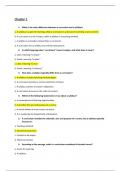Chapter 1
1. What is the main difference between a curriculum and a syllabus?
a. A syllabus is a plan for learning, while a curriculum is a document outlining course content.
b. A curriculum is a list of topics, while a syllabus is a teaching method.
c. A syllabus is a broader concept than a curriculum.
d. A curriculum and a syllabus are entirely synonymous.
2. In which language does "curriculum" have its origins, and what does it mean?
a. Latin, meaning "to teach."
b. Greek, meaning "to plan."
c. Latin, meaning "to run."
d. Greek, meaning "to discuss."
3. How does a syllabus typically differ from a curriculum?
a. A syllabus includes teaching methodologies.
b. A curriculum provides a concise statement of topics.
c. A syllabus outlines a teacher's objectives.
d. A curriculum focuses on the order of content.
4. Which of the following statements is true about a syllabus?
a. It encompasses all learning opportunities.
b. It specifies the aim and purpose of a course.
c. It mainly follows a linear course structure.
d. It is created by the Department of Education.
5. A curriculum includes the rationale, aim, and purpose of a course, but a syllabus typically
focuses on:
a. Teaching methods.
b. Assessment practices.
c. Content to be taught.
d. Historical context.
6. According to the passage, what is a curriculum considered in broader terms?
a. A plan for learning.
b. A syllabus.
,c. A teaching strategy.
d. All learning guided by teachers.
7. Which term refers to the implicit teaching that is not explicitly stated in the curriculum or
syllabus?
a. Hidden curriculum.
b. Covert curriculum.
c. Assessed curriculum.
d. Enacted curriculum.
8. What does a syllabus primarily provide?
a. A plan for teaching.
b. A list of learning objectives.
c. A concise statement of topics.
d. A historical perspective on education.
9. In the context of the passage, why is it important to distinguish between a curriculum and
a syllabus?
a. To understand their historical origins.
b. To analyse their social and political implications.
c. To compare their teaching methodologies.
d. To determine their relevance in modern education.
10. How do syllabi typically organize content?
a. By including rationale and purpose.
b. By following a logical sequence.
c. By emphasizing teaching methods.
d. By encompassing all learning opportunities.
MCQs for "Defining a Curriculum":
11. What are the two different views of the curriculum mentioned by Stenhouse in the
passage?
a. Curriculum as a plan and curriculum as a subject.
b. Curriculum as an ideal and curriculum as a reality.
c. Curriculum as a syllabus and curriculum as teaching methods.
d. Curriculum as official documentation and curriculum as hidden content.
12. How does Eisner define a curriculum?
,a. A series of planned events for learners.
b. The inter-related totality of aims, content, and teaching methods.
c. The official curriculum prescribed by education authorities.
d. A course of study or study program.
13. According to the National Education Policy Initiative, what does the curriculum refer to?
a. The official, explicit, intended curriculum.
b. The knowledge necessary to achieve educational outcomes.
c. The teaching and learning activities provided by schools.
d. The selected content arranged into subjects.
14. What is the enacted curriculum, as described in the passage?
a. The official curriculum set by education authorities.
b. The curriculum as experienced and learned by students.
c. Hidden teaching strategies that teachers employ.
d. The curriculum taught exactly as intended.
15. In the context of the passage, what does the "covert curriculum" focus on?
a. Teaching explicit subjects.
b. Developing important attitudes and skills.
c. Creating a detailed syllabus.
d. Hidden curriculum from teachers.
16. What does the "hidden curriculum" refer to?
a. Learning that is hidden from teachers but not from learners.
b. Implicit learning that teachers intentionally include in the curriculum.
c. Curriculum assessments and outcomes.
d. Curriculum content that is unintentionally hidden from learners.
17. What aspect of the curriculum is measured to determine learner achievement?
a. Official, explicit, intended curriculum.
b. Covert curriculum.
c. Assessed/attained curriculum.
d. Enacted curriculum.
18. According to the passage, what factors can affect the enacted curriculum?
a. The official curriculum and teaching methodologies.
, b. Teacher knowledge and resources.
c. Student preferences and school policies.
d. Government regulations and syllabus design.
19. Which term represents the curriculum as it is actually experienced and learned by
students?
a. Hidden curriculum.
b. Covert curriculum.
c. Enacted curriculum.
d. Assessed curriculum.
20. What does the curriculum include, according to the passage?
a. The intended curriculum and the syllabus.
b. The teaching methods and teacher qualifications.
c. The official, explicit, intended curriculum, and the enacted curriculum.
d. A plan for learning, content to be learned, and teaching and learning processes.
21. What is the primary focus of curriculum development?
a. Maintaining the status quo
b. Enhancing and innovating in education
c. Creating a standardized curriculum
d. Documenting existing curriculum
22. How does the curriculum development process typically unfold?
a. It is a linear, one-time process.
b. It involves a cyclical process of design, implementation, and evaluation.
c. It focuses only on specific local contexts.
d. It is based on desires rather than ideals.
23. Which of the following is NOT one of the core activities in curriculum development, as per
Figure 1.1?
a. Analysis
b. Documentation
c. Implementation
d. Evaluation
24. During the curriculum development process, what role does evaluation play?
a. It is of minimal importance.




